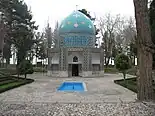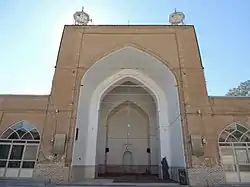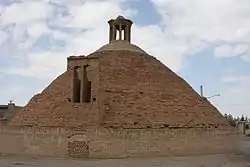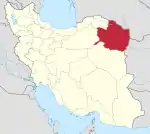Razavi Khorasan province
Razavi Khorasan or Central Khorasan Province (Persian: استان خراسان رضوی یا خراسان مرکزی, Ostân-e Xorâsân-e Razavi) is one of the 31 provinces of Iran, located in northeastern Iran. The city of Mashhad is the center and capital of the province. Central Khorasan is one of the three provinces that were created after the division of Khorasan province in 2004. In 2014, it was placed in Region 5[4] with Mashhad as the location of the region's secretariat.
Razavi Khorasan Province
استان خراسان رضوی | |
|---|---|
    .jpg.webp)  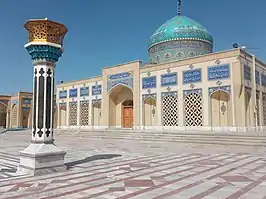 | |
 Location of Khorasan-e Razavi province in Iran | |
| Coordinates: 36.2980°N 59.6057°E | |
| Country | Iran |
| Region | Region 5 |
| Capital | Mashhad |
| Counties | 33 |
| Government | |
| • Governor-general | Yaghob-Ali Nazari |
| Area | |
| • Total | 118,884 km2 (45,901 sq mi) |
| Highest elevation | 3,211 m (10,535 ft) |
| Lowest elevation (Sarakhs) | 299 m (981 ft) |
| Population (2016)[1] | |
| • Total | 6,434,501 |
| • Estimate (2020) | 6,871,000[2] |
| • Density | 54/km2 (140/sq mi) |
| Demonym | Khorasani (Persian: خراسانی) |
| Time zone | UTC+03:30 (IRST) |
| Area code | 051 |
| Main language(s) | Persian |
| HDI (2017) | 0.781[3] high · 19th |
| Website | http://ostandari.khorasan.ir/ |
At the time of the National Census of 2006, the province had a population of 5,515,980 in 1,426,187 households.[5] The following census in 2011 counted 5,994,402 people in 1,716,314 households.[6] At the latest census conducted in 2016, the population had risen to 6,434,501 in 1,938,703 households.[1]
History
The Greater Khorasan has witnessed the rise and fall of many dynasties and governments in its territory throughout history. Various tribes of the Arabs, Turks, Kurds and Turkmens brought changes to the region time and time again.[7]
Ancient geographers of Iran divided Iran ("Ērānshahr") into eight segments of which the most flourishing and largest was the territory of Greater Khorasan. Esfarayen, among other cities of the province, was one of the focal points for residence of the Aryan tribes after entering Iran.
The Parthian Empire was based near Merv in Khorasan for many years. During the Sassanid dynasty, the province was governed by a Spahbod (Lieutenant General) called "Padgošban" and four margraves, each commander of one of the four parts of the province.
Khorasan was divided into four parts during the Muslim conquest of Persia, each section being named after the four largest cities, Nishapur, Merv, Herat, and Balkh.
In the year 651, the army of the Rashidun Caliphate conquered Khorasan. The territory remained under the rule of the Abbasid Caliphate until 820, followed by the rule of the Iranian Tahirid dynasty until 873, and the Samanid dynasty in 900.
Mahmud of Ghazni conquered Khorasan in 994, and Tuğrul in the year 1037.
In 1507, Khorasan was occupied by the Uzbek tribes. After the death of Nader Shah in 1747, it was occupied by the Afghan Durrani Empire centered in Qandahar.
In 1824, Herat became independent for several years when the Afghan Empire was split between the Durranis and Barakzais. The Persians sieged the city in 1837, but the British assisted the Afghans in repelling them. In 1856, the Persians launched another invasion and briefly managed to recapture the city; it led directly to the Anglo-Persian War. In 1857 hostilities between the Persians and the British ended after the Treaty of Paris was signed, and the Persian troops withdrew from Herat.[8] Afghanistan reconquered Herat in 1863 under Dost Muhammad Khan, two weeks before his death.[9]
Khorasan was the largest province of Iran until it was divided into three provinces on 29 September 2004. The provinces approved by the parliament of Iran (on 18 May 2004) and the Council of Guardians (on 29 May 2004) were Khorasan-e Razavi, North Khorasan, and South Khorasan.
Archaeological sites
Among the archeological sites discovered in this province:
Kohandezh hills
Excavations conducted by an American team between 1935 and 1940 in Nishapur discovered museum-worthy objects, which were shared with the government of the Shah. The Metropolitan Museum of Art's publications document its own Nishapur ceramics from those excavations. For half a century after 1945 the site of Nishapur was ransacked to feed the international market demand for early Islamic works of art. Nowadays, the Kohandezh hills reveal the remains from those excavations.
Shadiyakh
Shadiyakh was an important palace in old Nishapur up to the 7th century, and became more important and populated after that. The palace was completely ruined in the 13th century. It was the home of notables such as Farid al-Din Attar, whose tomb is found in Shadiyakh.
Demographics
The major ethnic group in this region are Persians, there are other sizeable communities such as Khorasani Kurds, Khorasani Turks, Turkmens and Baluchs.[10]
Administrative divisions

| Administrative Divisions | 2006[5] | 2011[6] | 2016[1] |
|---|---|---|---|
| Bajestan County1 | — | 30,664 | 31,207 |
| Bakharz County2 | — | 53,582 | 54,615 |
| Bardaskan County | 68,392 | 72,626 | 75,631 |
| Chenaran County | 108,533 | 125,601 | 155,013 |
| Dargaz County | 73,439 | 74,326 | 72,355 |
| Davarzan County3 | — | — | 21,911 |
| Fariman County | 86,428 | 93,930 | 99,001 |
| Firuzeh County4 | — | 42,739 | 37,539 |
| Golbahar County5 | — | — | — |
| Gonabad County | 106,158 | 80,783 | 88,753 |
| Joghatai County3 | — | 47,920 | 49,175 |
| Joveyn County3 | — | 54,139 | 54,488 |
| Kalat County | 39,560 | 38,232 | 36,237 |
| Kashmar County | 146,536 | 157,149 | 168,664 |
| Khaf County | 108,964 | 121,859 | 138,972 |
| Khalilabad County | 44,993 | 49,111 | 51,701 |
| Khoshab County3 | — | 37,914 | 37,181 |
| Kuhsorkh County6 | — | — | — |
| Mahvelat County | 47,068 | 48,900 | 51,409 |
| Mashhad County | 2,848,637 | 3,069,941 | 3,372,660 |
| Nishapur County | 441,184 | 433,105 | 451,780 |
| Quchan County | 179,613 | 179,714 | 174,495 |
| Roshtkhar County | 57,247 | 60,632 | 60,689 |
| Sabzevar County | 429,187 | 319,893 | 306,310 |
| Salehabad County7 | — | — | — |
| Sarakhs County | 85,524 | 89,956 | 97,519 |
| Sheshtamad County3 | — | — | — |
| Taybad County | 143,205 | 108,424 | 117,564 |
| Torbat-e Heydarieh County | 261,917 | 210,390 | 224,626 |
| Torbat-e Jam County | 239,395 | 262,712 | 267,671 |
| Torqabeh and Shandiz County8 | — | 58,483 | 69,640 |
| Zaveh County9 | — | 71,677 | 67,695 |
| Zeberkhan County4 | — | — | — |
| Total | 5,515,980 | 5,994,402 | 6,434,501 |
| 1Separated from Gonabad County 2Separated from Taybad County 3Separated from Sabzevar County 4Separated from Nishapur County 5Separated from Chenaran County 6Separated from Kashmar County 7Separated from Torbat-e Jam County 8Separated from Mashhad County 9Separated from Torbat-e Heydarieh County | |||
Cities
According to the 2016 census, 4,700,924 people (over 73% of the population of Razavi Khorasan province) live in the following cities: Ahmadabad-e Sowlat 8,326 ,Anabad 6,186, Bajestan 11,741, Bajgiran 594, Bakharz 9,044, Bar 3,765, Bardaskan 28,233, Bayg 3,545, Bidokht 5,501, Chapeshlu 2,374, Chekneh 1,381, Chenaran 53,879, Dargaz 36,762, Darrud 5,717, Davarzan 2,744, Dowlatabad 9,329, Eshqabad 1,993, Farhadgerd 8,442, Fariman 39,515, Feyzabad 18,120, Firuzeh 5,884, Golbahar 36,877, Golmakan 8,373, Gonabad 40,773, Hemmatabad 1,274, Jangal 6,650, Joghatai 9,268, Kadkan 3,719, Kakhk 4,625, Kalat 7,687, Kariz 11,102, Kashmar 102,282, Khaf 33,189, Khalilabad 12,751, Kharv 13,535, Kondor 6,460, Lotfabad 1,865, Mashhad 2,987,323, Mashhad Rizeh 10,105, Mashhad Zhaman 13,861, Mazdavand 1,241, Molkabad 2,056, Nashtifan 9,176, Nasrabad 7,460, Neqab 14,783, Nilshahr 7,371, Nishapur 264,375, Now Khandan 2,634, Qadamgah 3,010, Qalandarabad 4,880, Qasemabad 5,145, Quchan 101,604, Razaviyeh 8,850, Rivash 5,687, Robat-e Sang 1,551, Roshtkhar 7,514, Rud Ab 4,028, Sabzevar 243,700, Salami 7,555, Salehabad 8,625, Sangan 12,443, Sarakhs 42,179, Sefid Sang 6,129, Shadmehr 3,825, Shahrabad 2,083, Shahr-e Zow 3,745, Shandiz 13,987, Sheshtomad 3,108, Soltanabad 5,932, Taybad 56,562, Torbat-e Heydarieh 140,019, Torbat-e Jam 100,449, Torqabeh 20,998, and Yunesi 3,426.[1]
The following sorted table lists the most populous cities in Razavi Khorasan according to 2016 Census results announced by Statistical Center of Iran.[1] After Mashhad, Nishapur, Sabzevar, and Torbat-e Heydarieh are the most populous cities of the province.
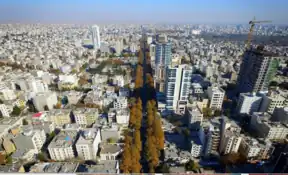
Mashhad
Nishapur |
Rank | City | County | Population | .jpg.webp)
Sabzevar
Torbat-e Heydarieh |
|---|---|---|---|---|---|
| 1 | Mashhad | Mashhad | 2,987,323 | ||
| 2 | Nishapur | Nishapur | 264,375 | ||
| 3 | Sabzevar | Sabzevar | 243,700 | ||
| 4 | Torbat-e Heydarieh | Torbat-e Heydarieh | 140,019 | ||
| 5 | Kashmar | Kashmar | 102,282 | ||
| 6 | Quchan | Quchan | 101,604 | ||
| 7 | Torbat-e Jam | Torbat-e Jam | 100,449 | ||
| 8 | Taybad | Taybad | 56,562 | ||
| 9 | Chenaran | Chenaran | 53,879 | ||
| 10 | Sarakhs | Sarakhs | 42,179 |
Culture
Attractions
This province contains many historical and natural attractions, such as mineral water springs, small lakes, recreational areas, caves and protected regions, and various hiking areas.
Besides these, Khorasan encompasses numerous religious buildings and places of pilgrimage, including the shrine of Imam Reza, Goharshad mosque and many other mausoleums and Imamzadehs which attract visitors to this province.
The Cultural Heritage of Iran lists 1179 sites of historical and cultural significance in all three provinces of Khorasan.
Some of the popular attractions of Khorasan-e Razavi are:
Mashhad
Nishapur
Sabzevar
Kashmar
- Arg of Kashmar
- Tomb of Hassan Modarres
- Imamzadeh Seyed Morteza
- Imamzadeh Hamzeh, Kashmar
- Imamzadeh Mohammad
- Grave of Pir Quzhd
- Jameh Mosque of Kashmar
- Haj Soltan Religious School
- Haji Jalal Mosque
- Atashgah Manmade-Cave
- Atashgah Castle
- Kohneh Castle, Zendeh Jan
- Rig Castle
- Amin al-tojar Caravansarai
- Talaabad Watermill
- Yakhchāl of Kashmar
Khalilabad
- Jameh Mosque of Khalilabad
- Kondor castle
- Kondor Ab anbars
Gonabad
- Forud castle
- Qanats of Gonabad
- Kūh-Zibad
Bardaskan
- Tomb of Abdolabad
- Aliabad Tower
- Firuzabad Tower
- Firuzabad area
- Seyyed Bagher Ab anbar
- Darone Cave
- Sir Cave
- Rahmanniyeh Castle
- Qal'eh Dokhtar, Khooshab
- Qal'eh Dokhtar, Doruneh
Rivash
Colleges and universities
- Asrar Institute of Higher Education[11]
- Bahar Institute of Higher Education[12]
- Comprehensive University of Applied and Practical Sciences, Khorasan[13]
- Ferdowsi University of Mashhad[14]
- Gonabad University of Medical Sciences[15]
- Hakim-e Sabzevari University of Sabzevar[16]
- Imam Reza University[17]
- Islamic Azad University of Bardaskan
- Islamic Azad University of Ghoochan
- Islamic Azad University of Gonabad[18]
- Islamic Azad University of Mashhad
- Islamic Azad University of Neishabur
- Islamic Azad University of Sabzevar[19]
- Islamic Azad University of Torbat e Jam
- Islamic Azad University of Torbat Heidariyeh
- Mashhad University of Medical Sciences
- Payame Noor University of Bardaskan
- Payame Noor University of Mashhad
- Sabzevar University of Medical Sciences[20]
- Sadjad University of Technology[21]
- Sport Sciences Research Institute of Iran
Gallery
References
- "Census of the Islamic Republic of Iran, 1395 (2016)". AMAR (in Persian). The Statistical Center of Iran. p. 09. Archived from the original (Excel) on 2 April 2022. Retrieved 19 December 2022.
- "جمعیت". amar.org.ir.
- "Sub-national HDI - Area Database - Global Data Lab". hdi.globaldatalab.org. Retrieved 13 September 2018.
- "همشهری آنلاین-استانهای کشور به ۵ منطقه تقسیم شدند (Provinces were divided into 5 regions)". Hamshahri Online (in Persian). 22 June 2014. Archived from the original on 23 June 2014.
- "Census of the Islamic Republic of Iran, 1385 (2006)". AMAR (in Persian). The Statistical Center of Iran. p. 09. Archived from the original (Excel) on 20 September 2011. Retrieved 25 September 2022.
- "Census of the Islamic Republic of Iran, 1390 (2011)" (Excel). Iran Data Portal (in Persian). The Statistical Center of Iran. p. 09. Retrieved 19 December 2022.
- "CSKK - Kurds in Khorasan". cskk.org.
- Avery, Peter; Hambly, Gavin; Melville, Charles, eds. (1991). The Cambridge History of Iran (Vol. 7): From Nadir Shah to the Islamic Republic. Cambridge University Press. pp. 183, 394–395. ISBN 978-0521200950.
- Ewans (2002). Afghanistan: A short History of its People and Politics. Perennial. pp. 77. ISBN 006-050508-7.
- https://www.iranicaonline.org/articles/khorasan-1-ethnic-groups
- "Home". asrar.ac.ir.
- "مؤسسه آموزش عالی غیرانتفاعی بهار مشهد – مؤسسه آموزش عالی غیرانتفاعی بهار مشهد – دانشگاه بهار مشهد".
- "Welcome to ISATC 1". 11 February 2005. Archived from the original on 11 February 2005.
- "دانشگاه فردوسی مشهد - دانشگاه فردوسی مشهد". www.um.ac.ir.
- "دانشگاه علوم پزشکی و خدمات بهداشتی درمانی گناباد". www.gmu.ac.ir.
- "دانشگاه حکیم سبزواری – دانشگاه حکیم سبزواری پویا در عرصه ملی پیشرو در مسیر توسعه".
- "دانشگاه بین المللی امام رضا (علیه السلام)". دانشگاه بین المللی امام رضا (علیه السلام).
- "دانشگاه آزاد اسلامی گناباد". iau-gonabad.ac.ir.
- "دانشگاه آزاد اسلامی سبزوار". www.iaus.ac.ir.
- "دانشگاه علوم پزشكي سبزوار - صفحه اصلی". www.medsab.ac.ir.
- "دانشگاه صنعتی سجاد". www.sadjad.ac.ir.
External links
![]() Media related to Razavi Khorasan Province at Wikimedia Commons
Media related to Razavi Khorasan Province at Wikimedia Commons
- The text of the law for division of Khorasan into three provinces (in Persian)
- Cultural Heritage Foundation of Khorasan
- Khorasan-e Razavi Province cooprative office
- Khorasan-e Razavi Province cooprative office (in Persian)
- Khorasan-e Razavi Province Department of Education (in Persian)
- Imam Reza Shrine Official website
- Mashad Mayor's Office
- Central Library of Astan Quds Razavi Official website


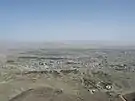









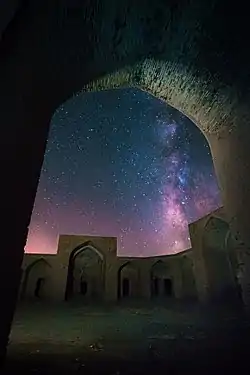



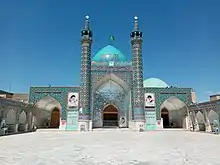
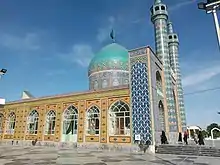
.jpg.webp)
